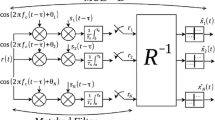Abstract
In order to accommodate different types of traffic in future wirelesscommunications, it is necessary to consider a system, which can operatesatisfactorily at multiple transmission rates. Due to its capability to copewith the hostile frequency selective fading, that limits transmission rate,and its suitability to handle multi-rate data, multi-carrier CDMA (MC-CDMA)has recently drawn considerable attention as a suitable candidate forsupporting multimedia services in wireless communications. Multi-rate accessschemes where users are able to transmit at different data rates on MC-CDMAsystems are presented in this paper. Four multi-rate access schemes: uncodedfixed spreading length (UFSL), coded fixed spreading length (CFSL), multi-codefixed spreading length (MFSL) and variable spreading length (VSL) schemes areproposed. With these schemes, different traffic such as voice, video and highrate data can be transmitted seamlessly through one MC-CDMA infrastructure.A chip-level minimum mean square error combining (MMSEC) technique is employedfor joint energy combining and interference cancellation purpose. Theperformance of these schemes with MMSEC is compared by both theoreticalderivations and simulation results under frequency selective Rayleigh fadingchannels.
Similar content being viewed by others
References
T. Ojanpera and R. Prasad, “An Overview of Air Interface Multiple Access for IMT-2000/UMTS”, IEEE Commun. Mag., Vol. 36, No. 9, pp. 82–86, 91–95, 1998.
J.F. Huber, D. Weiler and H. Brand, “UMTS, the Mobile Multimedia Vision for IMT-2000: A Focus on Standardization”, IEEE Commun. Mag., Vol. 38, No. 9, 2000.
R. Prasad, CDMA for Wireless Personal Communication, Artech, 1996.
T. Ottosson and A. Svensson, “On Schemes for Multirate Support in DS-CDMA Systems”, Proc. Wireless Personal Communications, Vol. 6, No. 3, pp. 265–287, 1998.
E.A. Sourour and M. Nakagawa, “Performance of Orthogonal Multicarrier CDMA in a Multipath Fading Channel”, IEEE Trans. on Commun., Vol. 44, No. 3, 1996.
K. Fazel and G.P. Fettweis, Multicarrier Spreading-Spectrum, Kluwer Academic Publishers, 1997.
S. Hara and R. Prasad, “Overview of Multicarrier CDMA”, IEEE Commun. Mag., Vol. 35, No. 12, pp. 126–133, 1997.
S. Hara and R. Prasad, “Design and Performance of Multicarrier CDMA System in Frequency-Selective Rayleigh Fading Channels”, IEEE Trans. on Vehic. Tech., Vol. 48, No. 5, 1999.
P. Zong, Y. Bar-Ness and J. Chan, “Performance Analysis of a Dual-Rate Synchronous MC-CDMA System”, Proc. IEEE GLOBECOM, Vol. 3, pp. 1380–1384, 2000.
P. Zong, K. Wang and Y. Bar-Ness, “Performance Improvement for Low-Rate Signal in a Dual-Rate MCCDMA System with Frequency-Selective Rayleigh Fading Channel”, in Proc. WPMC, Sept. 2001.
M. Tan, C. Ibars and Y. Bar-Ness, “Rate-Adaptive Convolutional Coded Fixed Spreading Length (CCFSL) Multi-Rate Transmission Schemes for MC-CDMA”, in Proc. WPMC, 2002.
M. Tan and Y. Bar-Ness, “Maximum Spectral Utilization Efficiency Multi-Code FSL Scheme for Multi-Rate MC-CDMA”, in Proceeding of 3G Wireless, 2002.
P. Zong and Y. Bar-Ness “Performance of a Variable Spreading Length (VSL) Dual-Rate MC-CDMA System”, in Proc. CISS, 2001.
A. Chouly, A. Brajal and S. Jourdan, “Orthogonal Multicarrier Techniques Applied to Direct Sequence Spread Spectrum CDMA Systems”, Proc. IEEE GLOBECOM, Vol. 3, pp. 1723–1728, 1993.
A. Leon-Garcia, Probability and Random Processes for Electrical Engineering, Addison-Wesley, 1994.
W.C. Jackes, Microwave Mobile Communications, Wiley: New York, 1974.
M. Saquib, R. Yates and N. Mandayan, “Decorrelating Detectors for a Dual Rate Synchronous DS/CDMA Channel”, Proc. Wireless Personal Communications, pp. 197–216, 1999.
J. Chen and U. Mitra, “Analysis of Decorrelator-Based Receivers for Multi-Rate DS/CDMA Communications”, IEEE Trans. on Vehic. Tech., Vol. 48, pp. 1966–1983, 1999.
P. Zong, K. Wang and Y. Bar-Ness, “Partial Sam[ling MMSE Interference Suppression in Asynchronous Multicarrier CDMA System”, IEEE J. Select Areas Commun., Vol. 19, No. 8, pp. 1605–1613, 2001.
J.G. Proakis, Digital Communications, McGraw-Hill Inc., 1995.
J. Hagenauer, N. Seshadri and C.-E. Sundberg, “The Performance of Rate-Compatible Punctured Convolutional Codes for Digital Mobile Radio”, IEEE Trans. on Commun., Vol. 38, No. 7, pp. 966–980, 1990.
U. Mitra, “Comparison of Maximum-Likelihood-Based Detection for Two Multirate Access Schemes for CDMA System”, IEEE Trans. on Commun., Vol. 47, No. 1, pp. 64–77, 1999.
C. Ibars and Y. Bar-Ness, “The Principle of Time-Frequency Duality of DS and MC-CDMA”, in Proc. CISS, 2002.
M. Tan and Y. Bar-Ness, “Performance Comparison of the Multi-Code Fixed Spreading Length (MFSL) Scheme and Variable Spreading Length (VSL) Scheme for Multi-Rate MC-CDMA”, in Proc. IEEE ISSSTA, 2002.
J.G. Proakis and D.G. Manolakis, Digital Signal Processing Principles, Algorithms, and Applications, Prentice Hall, 1996.
Author information
Authors and Affiliations
Rights and permissions
About this article
Cite this article
Tan, M., Zong, P. & Bar-Ness, Y. Multi-Rate Access Schemes for MC-CDMA. Wireless Personal Communications 27, 149–182 (2003). https://doi.org/10.1023/B:WIRE.0000003835.59701.43
Issue Date:
DOI: https://doi.org/10.1023/B:WIRE.0000003835.59701.43




